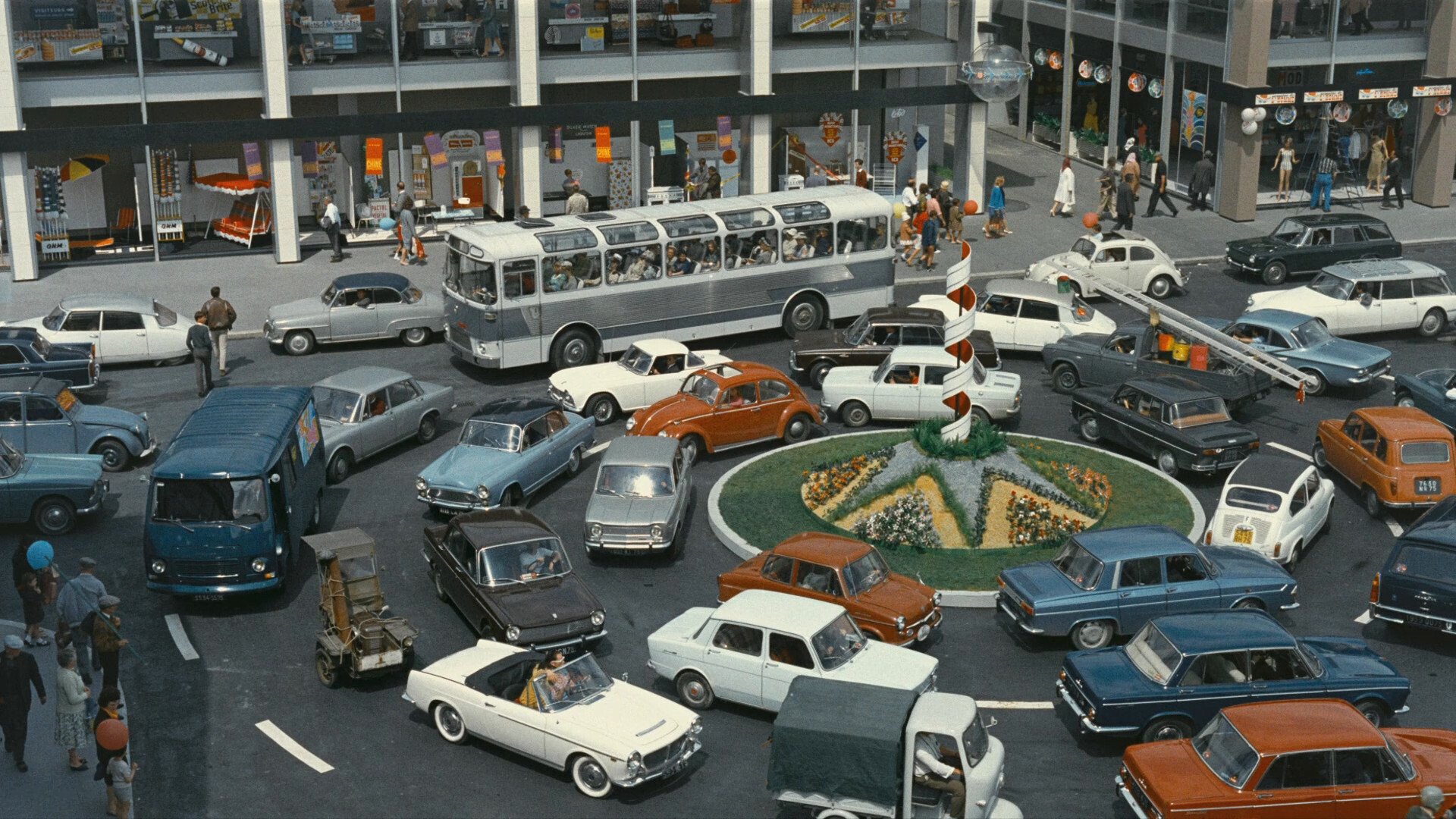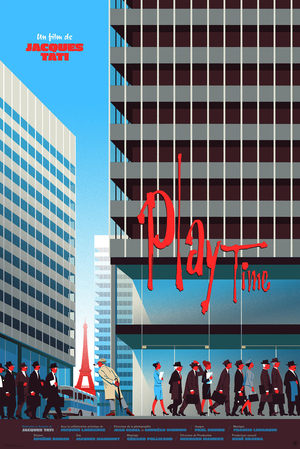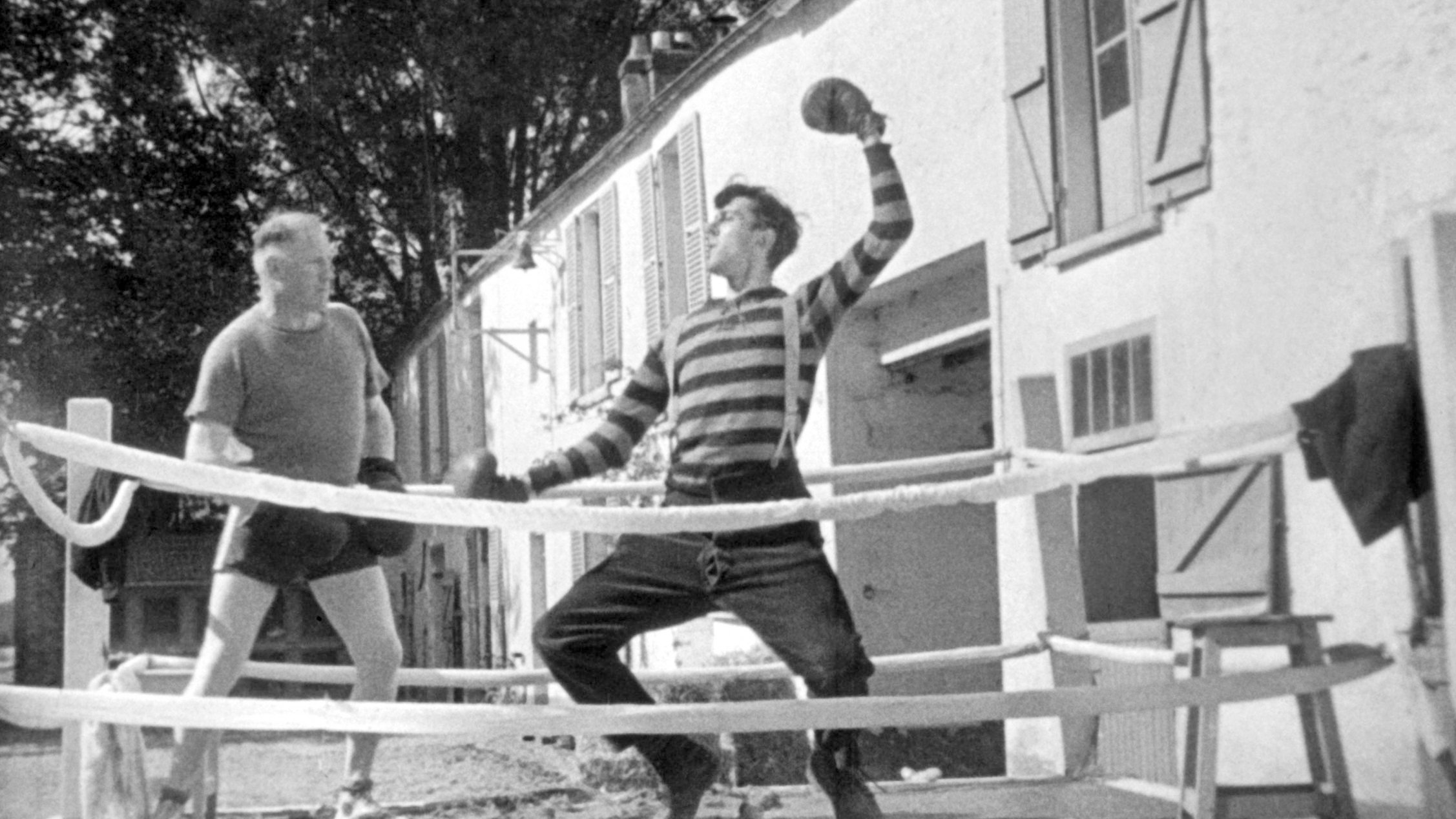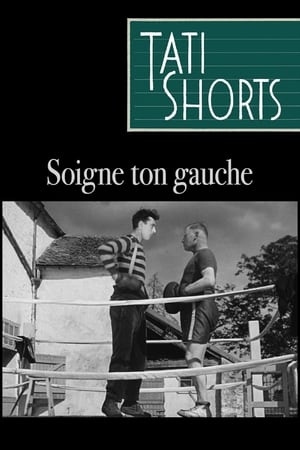Jacques Tati was a French actor, filmmaker, and comedian known for his charming and imaginative films that often explored the absurdities of modern life.
He rose to international acclaim in the 1950s and 1960s with a series of films that celebrated the pleasures and quirks of everyday existence, using his unique physical style and visual humor to create an indelible cinematic style.
Some of Jacques Tati’s best-known films include:
“Mr. Hulot’s Holiday” (1953): This film follows the hapless Mr. Hulot as he attempts to enjoy a seaside vacation, only to find himself constantly in the middle of various mishaps and misunderstandings.
The film is a charming and whimsical look at the foibles of human nature, and is notable for its inventive use of sound and visual gags.
“Mon Oncle” (1958): In this film, Tati reprises his role as Mr. Hulot, this time in a satirical take on modern architecture and design. The film pokes fun at the sterile, impersonal aesthetic of post-war modernism, and features a number of memorable scenes and sight gags.
“Playtime” (1967): This film is considered by many to be Tati’s masterpiece. It is a surreal, almost wordless work of art that follows the adventures of Mr. Hulot as he navigates a futuristic, ultra-modern Paris.
The film is notable for its elaborate set design, intricate choreography, and deep, underlying social commentary.
Best Jacques Tati Films
Jacques Tati’s films are known for their charm, wit, and inventiveness, and are beloved by audiences around the world for their ability to capture the joy and absurdity of everyday life.
1. Playtime (1967)


PlayTime
1967 • 1h 55min • ★ 7.8/10 • France
Directed by: Jacques Tati
Cast: Jacques Tati, Barbara Dennek, Rita Maiden, France Rumilly, France Delahalle
Clumsy Monsieur Hulot finds himself perplexed by the intimidating complexity of a gadget-filled Paris. He attempts to meet with a business contact but soon becomes lost. His roundabout journey parallels that of an American tourist, and as they weave through the inventive urban environment, they intermittently meet, developing an interest in one another. They eventually get together at a chaotic restaurant, along with several other quirky characters.
“Playtime” is a 1967 French comedy film directed by Jacques Tati. The film follows the character of Monsieur Hulot as he navigates a modernist Paris filled with technological innovations and cultural changes.
The film is noted for its visual style and use of architectural motifs, including the use of glass and steel buildings and the repetition of geometric patterns.
The film is a commentary on modern society, consumerism, and the ways in which new technologies and urbanization have changed human behavior.
The characters in the film struggle to communicate with one another and navigate the complex cityscape, highlighting the ways in which modern life can be isolating and alienating.
“Playtime” is notable for its complex and innovative visual design, including the use of long takes, deep focus photography, and complex tracking shots.
The film’s intricate sound design, which includes ambient noise and overlapping dialogue, adds to the immersive and often chaotic atmosphere.
Overall, “Playtime” is considered one of Tati’s masterpieces, and is regarded as a landmark in the history of cinema. Its innovative approach to storytelling and its use of comedy and visual design continue to influence filmmakers today.
- Playtime (1967) ( Play Time )
- Playtime (1967)
- Play Time
- Jacques Tati, Barbara Dennek, Rita Maiden (Actors)
- Jacques Tati (Director) - Playtime (1967) ( Play Time ) (Producer)
2. Mon Oncle (1958)
“Mon Oncle” is a 1958 French comedy film written, directed, and starring Jacques Tati. The film follows the adventures of Monsieur Hulot, a bumbling and affable man who struggles to fit in with the modern world.
The film is a satire of modern society, particularly the rise of consumer culture and the changing urban landscape.
Here are three reasons why you should watch “Mon Oncle”:
If you like Jacques Tati’s work, on our sister site AuteurGraph we have a profile page, a visual film timeline, and a ratings page that gives a tonne of info and data about their career in a visualized form.
Visual comedy: Jacques Tati was a master of visual comedy, using his unique sense of humor to create slapstick moments that are both hilarious and subtle. “Mon Oncle” is a perfect example of his style, with gags that range from small, almost imperceptible movements to large, over-the-top set pieces.
Critique of modern society: “Mon Oncle” offers a biting critique of modern society and the impact of consumer culture on our lives. Tati’s characters struggle to navigate the impersonal and dehumanizing architecture of modern cities, which he portrays as cold and sterile.
The film is a humorous and poignant commentary on the changes in French society after World War II.
Timeless appeal: Although “Mon Oncle” was released over 60 years ago, the film’s themes and humor still resonate with contemporary audiences.
Its timeless appeal lies in its universal message about the tension between modernization and tradition, and the challenges we face in adapting to a rapidly changing world. The film is a classic of French cinema and continues to be celebrated as a masterpiece of visual comedy and social satire.
- Jacques Tati, Jean-Pierre Zola (Actors)
- Jacques Tati (Director)
- English (Subtitle)
- Audience Rating: Unrated (Not Rated)
3. Monsieur Hulot’s Holiday (1953)
“Monsieur Hulot’s Holiday” is a 1953 French comedy film directed by Jacques Tati, who also stars as the titular character, Monsieur Hulot. The film is a lighthearted and whimsical look at the idiosyncrasies of vacationing, as Hulot and a group of other holiday-goers enjoy a beachside resort.
The film is notable for its visual humor, with much of the comedy coming from the absurd and exaggerated movements and actions of the characters.
The film is also known for its use of sound, with Tati utilizing natural sounds and background noise to create a rich and immersive audio environment.
One of the most striking aspects of “Monsieur Hulot’s Holiday” is its focus on observation and exploration. The film is not driven by plot, but rather by a series of loosely connected vignettes that showcase the quirks and foibles of the various characters.
It’s a film that rewards close attention and observation, and it’s a joy to watch the characters as they interact and navigate the world around them.
Overall, “Monsieur Hulot’s Holiday” is a charming and lighthearted film that celebrates the joys of vacationing and the idiosyncrasies of human behavior. It’s a classic of French cinema and a must-see for anyone who appreciates visual humor and whimsical storytelling.
- Korean (Subtitle)
- Korean (Publication Language)
4. Jour de Fête (1949)
“Jour de Fête” is a 1949 French comedy film written, directed by, and starring Jacques Tati. The film follows the misadventures of a bumbling and naive rural postman named François who becomes obsessed with modern postal delivery methods after attending a traveling fair.
“Jour de Fête” is known for its charming and whimsical portrayal of rural life in France, as well as Tati’s inventive use of sound and visual gags.
The film’s color photography was also groundbreaking for the time, and Tati’s use of long takes and unobtrusive camera work helped to create a sense of intimacy and authenticity.
Overall, “Jour de Fête” is considered to be a classic of French cinema and a defining work in Tati’s filmography. The film’s themes of tradition versus modernity, and the importance of human connection in a rapidly changing world, continue to resonate with audiences today.
5. School for Postmen (1947)
“School for Postmen” is a 1947 French comedy film written and directed by Jacques Tati. It was Tati’s first film as a director, and it was shot before but released after his breakthrough film, “Jour de Fête.”
The film is a short comedy that follows a group of bumbling postmen as they attend a training school to learn the proper way to deliver mail. As with Tati’s other films, the humor in “School for Postmen” comes from his use of physical comedy, sight gags, and deadpan humor.
“School for Postmen” is notable for being Tati’s first foray into filmmaking and for introducing many of the themes and techniques that would become hallmarks of his later work.
The film also marked the beginning of Tati’s long-standing fascination with the post office and the postal service, which would feature prominently in “Jour de Fête” and his later films.
Overall, “School for Postmen” is a charming and whimsical film that provides a glimpse into the early career of one of France’s most celebrated filmmakers.
It serves as an important precursor to Tati’s later, more elaborate works, and is a must-see for fans of his unique brand of physical comedy.
- English (Subtitle)
- Audience Rating: Unrated (Not Rated)
6. Evening Class (1967)
“Evening Class” is a 1967 Italian comedy-drama film directed by Vittorio De Sica. The film is based on a novel by Luigi Malerba and tells the story of a group of students attending an adult education course in Rome.
Here are three reasons why you should watch “Evening Class”:
Stellar cast: “Evening Class” features an outstanding cast, including iconic Italian actors such as Alberto Sordi, Monica Vitti, and Claudio Gora. Their performances are nuanced and engaging, bringing depth and humor to the characters they play.
Exploration of Italian society: The film offers an insightful look into Italian society in the 1960s, examining issues such as social class, religion, gender roles, and the generation gap.
It highlights the struggles and aspirations of the working-class characters and provides a fascinating glimpse into the cultural and social dynamics of the time.
De Sica’s directorial style: Vittorio De Sica was a master of Italian neorealism, a cinematic movement that emphasized the use of non-professional actors and real-life settings.
“Evening Class” is a departure from this style, but De Sica’s directorial talent is still evident in the film’s beautiful cinematography and skillful storytelling. The film seamlessly blends humor and drama, creating a complex and poignant portrait of modern Italy.
- Jacques Tati, Paul Demange, Max Martel (Actors)
- Jacques Tati (Director) - Jacques Tati (Writer) - Fred Orain (Producer)
7. Trafic (1971)
“Trafic” is a 1971 French comedy film directed by Jacques Tati, who also stars as Monsieur Hulot. The film follows Hulot as he sets out on a journey to Amsterdam to attend an international auto show, where he hopes to showcase his latest invention, a car that runs on compressed air.
As with Tati’s other films, “Trafic” is notable for its visual humor and subtle satire. The film pokes fun at the automobile industry and the excesses of consumer culture, as well as the absurdities of modern transportation and traffic management.
The film is also notable for its sound design, which is used to great effect to highlight the noise and chaos of modern life. Tati was a master of sound, and he used natural sounds and background noise to create a rich and immersive audio environment.
One of the most striking aspects of “Trafic” is its attention to detail. Tati was known for his meticulous approach to filmmaking, and the film is full of small details and visual gags that reward careful observation.
The film is a love letter to the absurdities and quirks of modern life, and it’s a joy to watch as Hulot navigates his way through a world that is both familiar and bizarre.
Overall, “Trafic” is a clever and whimsical film that celebrates the joys of observation and exploration. It’s a classic of French cinema and a must-see for anyone who appreciates visual humor and subtle satire.
- Amazon Prime Video (Video on Demand)
- Jacques Tati, Marcel Fraval, Honoré Bostel (Actors)
- Jacques Tati (Director) - Jacques Tati (Writer) - Robert Dorfmann (Producer)
- English (Playback Language)
- English (Subtitle)
8. Parade (1974 TV Movie)
“Parade” is a 1974 television movie directed by Jacques Tati. The film was a departure from Tati’s previous work, which had focused on narrative feature films. Instead, “Parade” is a performance film, featuring a group of performers moving through a variety of vignettes and scenes, often accompanied by live music.
The film’s visual style is heavily influenced by the world of circus and variety theater. Tati himself appears in the film, often playing the role of a ringmaster or conductor.
The performers in the film include clowns, acrobats, musicians, and other circus and variety acts. The film also features several surreal and dreamlike sequences, as well as moments of physical comedy.
“Parade” was an experimental work for Tati, and was not widely seen upon its initial release. However, the film has since gained a cult following and is now regarded as a unique and important entry in Tati’s body of work.
The film’s use of performance and visual spectacle, as well as its blending of comedy and surrealism, continue to inspire filmmakers and artists today.
9. Forza Bastia (1978)
No poster available
“Forza Bastia” is a 1978 French sports drama film directed by Jacques Tati’s son, Pierre Tati. The film follows the underdog Corsican football team SC Bastia as they compete in the UEFA Cup tournament against some of Europe’s best teams.
Here are three reasons why you should watch “Forza Bastia”:
Football action: “Forza Bastia” offers a thrilling look at the world of professional football, with exciting and realistic game footage. The film showcases the passion and dedication of the Bastia players as they battle it out on the field against formidable opponents, making for a thrilling and engaging watch.
Cultural exploration: The film also provides a fascinating look into Corsican culture, depicting the island’s unique identity and customs. The characters are portrayed as deeply connected to their land and their traditions, making for an intriguing exploration of the complexities of Corsican society.
Inspirational story: “Forza Bastia” is an inspirational story of an underdog team that defies the odds and triumphs against all expectations.
The film highlights the determination and resilience of the Bastia players, making for an uplifting and motivational watch. It is a testament to the power of teamwork and the importance of never giving up on your dreams.
No products found.
10. On demande une brute (1934)
On demande une brute” is a 1934 French comedy film directed by Charles Barrois. The film stars Fernandel as a meek and mild-mannered man named Fernand who is mistaken for a notorious gangster and is recruited to carry out a series of heists.
Despite his initial reluctance, Fernand eventually finds himself drawn into the world of crime, and he must use all of his wit and cunning to avoid getting caught by the police.
The film is notable for its clever use of mistaken identity and its exploration of the thin line between law-abiding citizens and career criminals. It’s also a showcase for Fernandel’s talents as a comic actor, as he delivers a hilarious and endearing performance as the hapless Fernand.
“On demande une brute” is a product of its time, and it reflects the popular fascination with gangsters and crime that was prevalent in the 1930s. However, the film also has a timeless quality, as it explores universal themes such as the desire for adventure and the allure of danger.
Overall, “On demande une brute” is a fun and engaging film that celebrates the joys of escapism and adventure. It’s a classic of French cinema and a must-see for anyone who appreciates clever storytelling and delightful comic performances.
- Jacques Tati (Actor)
- Jacques Tati (Director)
- English (Subtitle)
11. Gai dimanche! (1935)
“Gai dimanche!” is a 1935 French short film directed by Jacques Brel and Jacques Deval.
The film is a lighthearted comedy that follows two young friends, played by Jacques Brel and Pierre Dherte, as they spend a carefree Sunday afternoon exploring the streets of Brussels and getting into various misadventures along the way.
The film is notable for its use of location shooting, which was relatively uncommon at the time, and for the naturalistic performances of its two leads. It is a charming and playful film that captures the joy of youth and the simple pleasures of life.
While “Gai dimanche!” is not as well-known as some of Jacques Brel’s other works, it remains an important milestone in his career as a filmmaker and performer.
The film showcases Brel’s talents as a writer, actor, and singer, and provides a window into the vibrant and creative world of Belgian cinema in the 1930s.
- Jacques Tati (Actor)
- Jacques Tati (Director)
- English (Subtitle)
12. Watch Your Left (1936)


Watch Your Left
1936 • 0h 13min • ★ 5.7/10 • France
Directed by: René Clément
Cast: Jacques Tati, Max Martel, Louis Robur, Cliville, Jean Aurel
Roger, son of a farmer, wants to be a boxer, and gets his chance by filling in for a boxer's sparring partner. However, Roger does not know how to box and reads a rule book while in the ring.
“Watch Your Left” is a 1936 British comedy film directed by Marcel Varnel and starring the comedy duo of Bud Flanagan and Chesney Allen, known as Flanagan and Allen.
The film tells the story of two sailors, Albert (Bud Flanagan) and William (Chesney Allen), who are mistakenly assigned to a warship and end up getting involved in various mishaps and misadventures.
Along the way, they fall in love with two women, Molly (Valerie Hobson) and Daisy (Chili Bouchier), and have to rescue them from danger.
The film is notable for featuring several musical numbers performed by Flanagan and Allen, including the popular song “Underneath the Arches”.
It also features appearances by several well-known British actors of the time, including Peter Gawthorne, Athene Seyler, and Edward Lexy.
“Watch Your Left” was a box office success upon its release, and helped to establish Flanagan and Allen as one of the most popular comedy acts in Britain during the 1930s.
It is still considered a classic of British comedy and is remembered for its witty dialogue, slapstick humor, and catchy musical numbers.
3 Characteristics of Jacques Tati Films
acques Tati was a French filmmaker and actor known for his innovative approach to comedy and his unique cinematic style. Here are three characteristics commonly associated with Jacques Tati’s films:
Visual Comedy: Tati’s films were characterized by their use of visual humor, rather than relying on dialogue or traditional gags. Tati often used carefully choreographed physical comedy, elaborate sets, and complex camera work to create comedic situations that were both hilarious and visually stunning.
Satirical Commentary: Tati’s films often contained subtle but pointed social commentary, satirizing modern society and the rapid changes brought about by industrialization and technology.
His films often highlighted the absurdities of modern life and the ways in which people were becoming disconnected from each other and from the world around them.
Recurring Characters: Tati frequently played the same character in his films, a well-meaning but bumbling character named Monsieur Hulot.
Hulot was a lovable but hapless figure who often found himself in awkward situations due to his own clumsiness and lack of awareness. Hulot became a beloved figure in French cinema, and his antics and misadventures became a trademark of Tati’s work.
3 Reasons Why You Should Watch Jacques Tati Films
Sure, here are three reasons why you should watch Jacques Tati films:
Visual Humor: Jacques Tati was a master of visual humor. His films are full of inventive and whimsical gags that play with perspective, composition, and timing to create a unique brand of comedy that is both clever and endearing.
Tati’s films are a delight to watch, and they reward careful observation and attention to detail.
Satire: Tati’s films are not just funny, they are also subtly satirical. Tati used his films to poke fun at modern society, and to highlight the absurdities and excesses of consumer culture. Tati’s satire is never heavy-handed, but rather it is delivered with a light touch and a sense of affection for his subjects.
Cinematic Mastery: Tati was a true cinematic master, and his films are full of technical innovations and artful compositions. Tati’s use of sound and music is particularly notable, as he used natural sounds and background noise to create a rich and immersive audio environment.
Tati’s films are a celebration of the art of filmmaking, and they showcase the possibilities of the medium in a way that is both playful and profound.
Overall, Jacques Tati films are a unique and delightful experience. They are full of visual humor, clever satire, and cinematic mastery, and they celebrate the joys of observation and exploration. If you appreciate clever storytelling, whimsical humor, and inventive filmmaking, then Jacques Tati films are a must-see.
Best Jacques Tati Films – Wrapping Up
Jacques Tati was a French filmmaker and actor known for his unique comedic style and masterful use of sound and visual gags. He created a number of acclaimed films throughout his career, and here are some of his best:
“Playtime” (1967) – This film is a masterpiece of visual comedy, featuring Tati’s beloved character Monsieur Hulot as he navigates a futuristic Paris.
“Mon Oncle” (1958) – In this film, Tati plays Monsieur Hulot, who struggles to fit in with his modern, technology-obsessed family.
“Jour de Fête” (1949) – This was Tati’s debut film and features his first appearance as Monsieur Hulot, as a village postman who tries to improve his efficiency after seeing an American postal worker in action.
“Trafic” (1971) – In this film, Monsieur Hulot works as an automobile designer and navigates the challenges of transporting a new car to an international auto show.
“Les Vacances de Monsieur Hulot” (1953) – This film follows Monsieur Hulot on a chaotic vacation at a seaside resort.
Overall, Tati’s films are timeless classics that are still beloved by audiences and critics today. His unique brand of comedy and his skillful use of sound and visual gags make his films stand out as some of the greatest comedies ever made.


![Playtime (1967) ( Play Time ) [ NON-USA FORMAT, Blu-Ray, Reg.B Import - France ]](https://m.media-amazon.com/images/I/41M8ynxE7nS.jpg)


![Mr. Hulot's Holiday (1953) Jacques Tati, Nathalie Pascaud [All Region, Import, B & W]](https://m.media-amazon.com/images/I/51PcHvKfSNL.jpg)

![Jour De Fete [1949] [DVD]](https://m.media-amazon.com/images/I/51R4pelltHL.jpg)
![Jour de fête [Blu-ray]](https://m.media-amazon.com/images/I/51my+AwhO2L.jpg)
![Evening Classes [VHS]](https://m.media-amazon.com/images/I/51dnqaVJ10L.jpg)


![Parade [DVD]](https://m.media-amazon.com/images/I/41hco-e9o4L.jpg)

![Essential Jacques Tati [Blu-ray]](https://m.media-amazon.com/images/I/41OC4CxwnjL.jpg)
